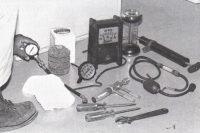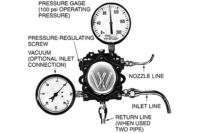Bob and Tim are at lunch after tuning up an oil burner. When they arrived at the job the home was cold and the oil burner was burning erratically if burning at all. They gave the system a tune-up, started the furnace, and decided to take a lunch break while the furnace heated the house. Then they were going back to do a combustion check on the furnace to make sure that it was set up for the best combustion.
“What exactly are we looking for in this combustion check?” Tim askes.
“An oil burner is the most sensitive heating unit that we work with as far as combustion efficiency is concerned. A gas furnace virtually needs no combustion analysis or tune-up in today’s market. The gas burners are designed so that dust does or cobwebs do not build up in the modern-day burners. There is just no room for adjustment with gas burners in today’s market in small appliances, and, of course, electric heat requires no adjustment. Heat pumps require the correct charge and maintenance, but it is nothing like an oil burner. The oil burner is burning a fuel that must be filtered, water must be removed from it, and the burner should be tested for efficiency every year,” said Bob.
“The things that we will be looking for are:
- The draft over the fire and in the flue. The draft tells us the vacuum is below atmospheric pressure, which will draw all the gases up the flue. The flue pipe must operate in a vacuum for the flue gases to rise up the chimney or flue pipe (Figure 1).
- We will also perform a smoke test, which will give us an indicator that the flue gases are burned as completely as possible (Figure 2).
- Then, we will do a full analysis to make sure the efficiency is as close as we can get to what the manufacturer recommends (Figure 3).
We will need the smoke test kit, the draft gage, and the electronic analysis kit.”
They made their way back to the job and started the furnace again as the house had warmed up and satisfied the need for the furnace. The first thing they did was put a thermometer in the flue gas pipe leaving the furnace. This is a standard efficiency fuel oil furnace that is piped up a metal flue pipe and has a draft diverter above the furnace to adjust the draft in the vent. They waited for the temperature to stop rising in the flue pipe and it stopped at about 660°F. They took the temperature in the room where the furnace was, in the basement. The room temperature was 60°. So, the net rise of combustion gases across the furnace was 600° (660°-60° = 600°).
They performed a smoke test in the flue pipe by drawing a known quantity sample of flue gas through a filter and comparing it to a template of comparisons. They found the flue gas had about 5 percent smoke, which was about correct for this furnace.
Then, they did a draft test over the fire and found the draft to be -0.02 inches of water column (W.C.) acceptable. Draft in the flu was about .05 inches of W.C., which looked real good for this furnace.
The next step was to do the combustion analysis test. They were looking for a CO2 reading of 8-10 percent. The combustion analysis test showed the CO2 range to be around 10 percent, which would give an efficiency of about 75 percent. This is quite normal for an oil furnace with a natural draft flue.
“If the flue gas temperature were to be too high, it would mean that too much air is flowing through the combustion chamber. There is an adjustable air adjustment on the side of the burner that can be moved for more air or, in this case, less air. The draft diverter can be adjusted if the draft is too great or too little. Other than that, the nozzle size and angle is determined by the manufacturer through testing on the unit when it is designed and built,” said Bob. “The newer oil furnaces can have much better efficiencies, upwards of 90 percent. This is accomplished by condensing moisture from the flue gases and getting more efficiency out of the heat exchanger by having it in contact with the room air heat exchanger for a longer period of time. This would be called a condensing oil furnace. It requires a condensate drain system that can handle the condensate which is slightly acidic”.
“Why would anybody purchase a low efficiency furnace when they could buy a high efficiency?” asked Tim.
“Many people will go for the first cost of an installation over efficiency. The condensing furnace cost much more than the normal atmospheric oil furnace,” replied Bob.
They had the system all checked out, and the efficiency was about as good as could be expected out of this type furnace, so the homeowner was set for another year of good operation. They explained to the homeowner what they had done and why. They were driving away in the truck when Tim said, “An oil burner arrangement is a sophisticated heating system compared to a gas furnace. And, it is completely different from a heat pump system. Both of these systems require quite a bit of attention to get good efficiency, so they must have their place in industry.”
“People who are away from the gas main cannot get natural gas, but they can use propane for fuel. Oil is probably considerably cheaper than propane to heat with. And, some people have always had oil and really enjoy the warm heat that comes from an oil furnace. When it is time for a new heating system, the oil burner duct system may not easily be adapted to a heat pump because the heat pump discharge air is much cooler than an oil furnace. The typical air temperature leaving a heat pump air system is about 100° while air from an oil furnace is usually around 120-130°. You can see why people who have had hot air coming from their system for many years may not want to drop back to a system with an air temperature that is much cooler. However, either system will heat a home equally well,” said Bob.
Publication date: 4/17/2017
Want more HVAC industry news and information? Join The NEWS on Facebook, Twitter, and LinkedIn today!













